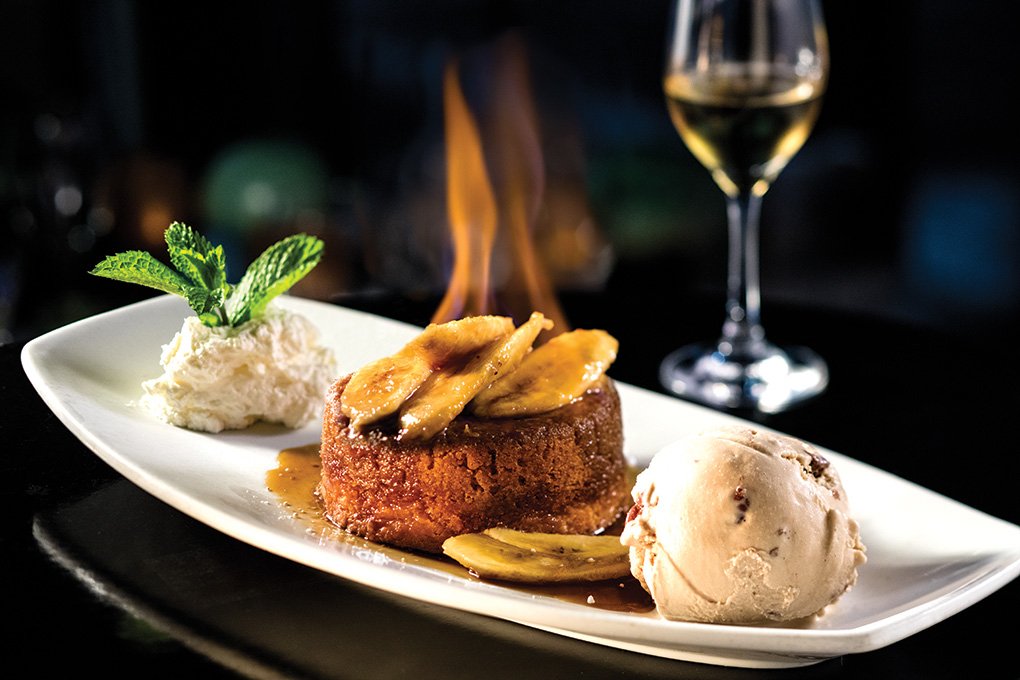When it comes to menu trends, the dessert category is more of a tortoise than a hare. While dessert menus are slower to alter from tried-and-true favorites, consumer dining and flavor preferences impact expectations on the sweet side of the menu, opening up opportunities for menu differentiation. Today, there’s more complex flavor play, unique and unusual pairings, desserts that connote homey comfort, and show-stopping numbers that beg to be shared on social media. All are attracting attention and driving sweet-toothed consumers to tempting dessert menus. Here, we have pinpointed five opportunities ready for menu innovation and broader adoption.
Butter Wins
There are words that connote comfort, indulgence and deep familiarity when used on the dessert menu, and butter is one of them. Take butterscotch for example: Chefs are finding this nostalgic confection of butter and brown sugar has enormous potential to marry to other more daring flavors, like miso and chile pepper. Meanwhile, buttermilk is a heritage flavor that speaks to Southern culinary tradition and implies a sense of homey, handmade fare. Butter cake, a moist, buttery cake that was originally spun off from the English pound cake, is also making big plays, boasting a Midwestern regional flair and promising an indulgent experience. In general, butter spells comfort, decadence and a long history of meal-ending bliss. Innovative takes on these “butter” desserts spell opportunity, tapping into a rich world of nostalgia and flavor.
One restaurant that successfully puts all three flavors together in a winning dessert is Eddie V’s, a Darden concept with locations across seven states. Its Hot “Bananas Foster” Butter Cake with butter pecan ice cream and butterscotch is a guest favorite. Butter cake, perhaps, offers the clearest pathway to signaturization—at its core, it’s a rich, yellow cake with loads of room for brand interpretation.
“We wanted to create a flavorful dessert that could properly cap off an unforgettable evening, and the rich butter cake combined with flavorful spices does just that,” says Adam Plaisance, executive chef at Eddie V’s Houston CityCentre location. “Our guests continue to order it for its vibrant flavors and rich texture, and they love that the cakes are baked to order and flambéed tableside, accompanied by small-batch local butter pecan ice cream.” Plaisance cautions chefs to pay special attention to the sweetness of the butter, but to ensure it has the right salt content, too.
At Zed451 in Chicago, the dessert menu includes a Butterscotch Bread Pudding, where buttery brioche is soaked in a rich butterscotch custard and topped with housemade marshmallow. Desserts like this showcase the power of butterscotch—even the word is evocative, serving up a warm, rich sweetness. Piccadilly Cafeteria, a chain with locations in Alabama, Florida and Georgia, features a Buttermilk Chess Pie with a hint of coconut in a flaky crust. Zingerman’s Delicatessen in Ann Arbor, Mich., offers a buttermilk cake filled with raspberry buttercream and covered in smooth vanilla Swiss buttercream. Both illustrate a sense of heritage and domesticity that works as a premium marker in the dessert category.
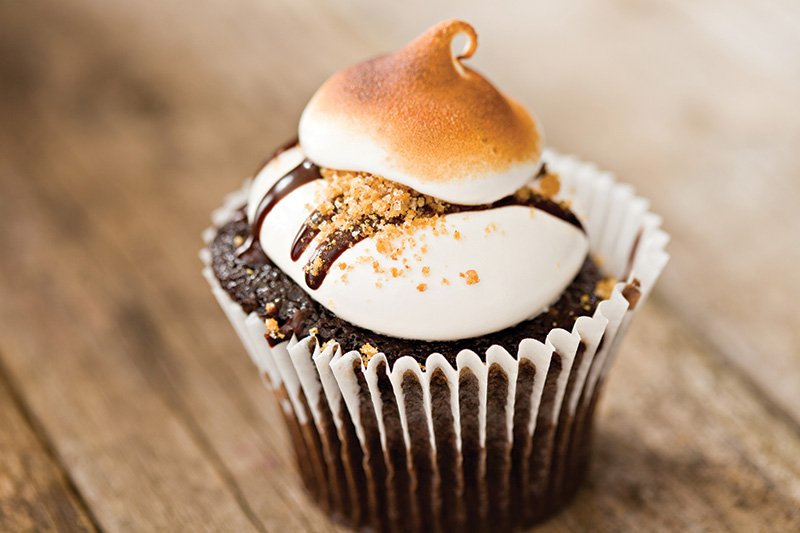
Dessert formats inspired by s’mores evoke nostalgia. A burnt marshmallow topping taps into those smoky-sweet flavor memories.
Smoke & Salt Add Intrigue
With modern flavor preferences leaning toward complexity, smoke and salt make a perfect play on dessert menus, pairing beautifully with the overlapping trends in burnt and caramelized flavors. Of course, s’mores have done their job warming diners up to the smoke trend, with many iterations of this campfire favorite evidenced throughout foodservice. For instance, Sea 180 Coastal Tavern offers Do-si-dos Peanut Butter S’mores Pie with housemade marshmallow and chocolate anglaise sauce.
More examples of how smoke and salt are playing out on menus include Salú in New Orleans, where the dark chocolate torte is paired with blackberry compote and burnt orange. Killen’s STQ in Houston serves a smoked chocolate cake, and at Salt & Straw, with locations in Portland, Ore., and Los Angeles, the Sea Salt with Caramel Ribbons ice cream stars fleur de sel and “hand-burned” caramel made in-house.
One of the most popular desserts at Alden & Harlow in Cambridge, Mass., is a smoked chocolate bread pudding served with Jacobsen Salt ice cream. Smoky and salty flavors go hand in hand, says Michael Scelfo, executive chef. He added the dessert to the menu three years ago and serves 20 a night, every night of the week. It took a lot of trial and error before the smoked brioche came out right, though. “We tried smoking several different elements, but cold-smoking the brioche turned it into a little sponge,” he says. “Working with salty and smoky flavors is just like balancing any other dish elements—you have to play with ratios. Chocolate and salt is pretty much a match made in heaven, but, in general, earthy flavors tend to work best with this combination. For example smoked apples, pears, squash and pumpkin work way better than anything with a high acid content.”
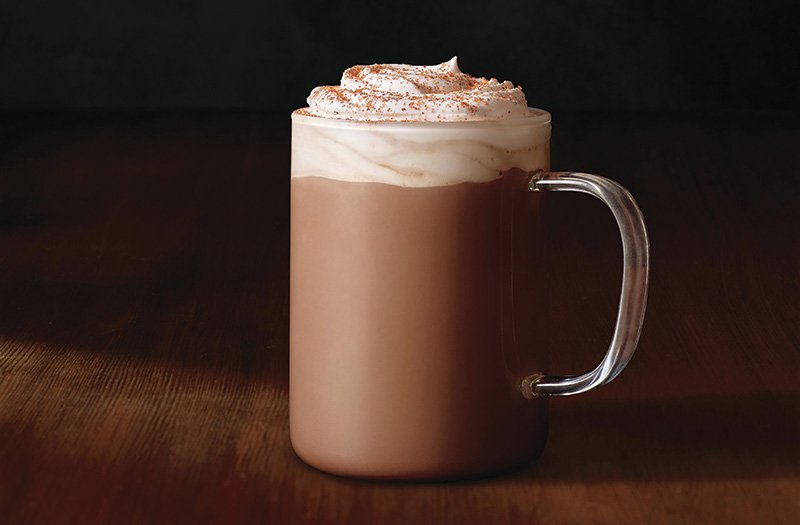
Ancho and cayenne chile spices give Starbucks’ new Chile Mocha an extra kick. Cocoa, cinnamon and vanilla provide the mellow sweetness.
Chile + Chocolate
Chile-laced Mexican hot chocolate might have helped warm consumers to the idea of this pairing. Driving it further into the familiar realm is retail snacking, where single-source chocolate is often spiked with fiery chiles—and maybe a bit of bacon for good measure. Even Starbucks’ coffee consumers are embracing the idea, as seen by the launch of Starbucks’ Chile Mocha, where cocoa gets hit with ancho and cayenne along with a bit of cinnamon and vanilla. The acceptance and enthusiasm around this pairing makes sense when you look at how modern flavor preferences continue to evolve, seeking out a bit of adventure, complexity and uniqueness. It is also a flavor pairing that works beautifully, uplifting both ingredients in a symbiotic way.
At Atrium Dumbo in Brooklyn, N.Y., a Valrhona dark chocolate mousse is served with Aleppo pepper, vanilla cream, chocolate crumble and hazelnuts. At Cicchetti in Seattle, the chocolate mousse dessert is served with Calabrian chile cream and cherry reduction. Aimee Graham, pastry chef at Cicchetti, introduced the dessert four months ago. “The spice, bitter chocolate and sweetness of the cherry reduction on the plate are really nice—they touch all the points on your tongue,” she says. “If diners are wary of the spice, they can introduce themselves slowly because the chile is in the cream.”
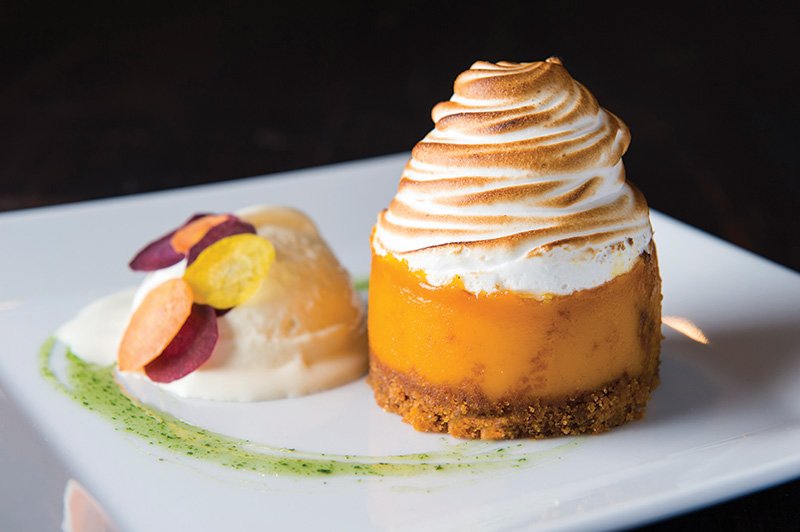 Dirt Candy
Dirt Candy Carrot Meringue shows off how effortlessly vegetables can play in the dessert world. The elegant dessert is one of
Dirt Candy’s top sellers.
Veg-Centric Gets Sweet
The prevalent veg-centric movement has demonstrated the flavor and textural potential of vegetables, where chefs are coaxing out deep, memorable flavors and consumers are eating them up. With vegetables like carrots and cauliflower now seen as menu stars, it’s no surprise that some pastry chefs are showing how desserts can boast veg-centric stardom, too.
At Dirt Candy, a vegetable-focused restaurant in New York, Amanda Cohen, chef/owner, has based every dessert around a vegetable since she first opened in 2008. As a pioneer in this arena, she continually demonstrates the potential for vegetables’ sweet side.
Her hit parade includes: Vegetable Ice Cream Salad, Corn Cake, Molten Beet Chocolate Cake and Watermelon Radish Beignets. Today, one of her most popular desserts is the Carrot Meringue Pie, a feature on the menu since 2014. “Carrot has a sweetness to it that makes it a no-brainer fit for most desserts,” she says. “What makes this dessert unusual is that we make a syrup for it out of the carrot tops, and it comes with candied rainbow carrot chips, so it’s very pretty. We get a lot of orders when people see it go out to other tables.” Cohen, who serves 20 to 30 orders of meringue pie each night, encourages chefs to experiment with adding vegetables to desserts. “You never know what’s going to work out,” she says. “One of my favorite desserts we came up with is our Celery Cheesecake Roll, and another crowd pleaser is our Chocolate Onion Tart.”
Datassential notes that naturally sweet vegetables like corn, carrots and beets are the most likely dessert ingredients, but savory vegetables are also gaining ground among the more adventurous dessert menus: avocado, squash and zucchini are all making appearances.
Eighty3 Food & Drink in Memphis, Tenn., menus parsnips in anglaise sauce paired with port-poached mirliton (a vegetable, also known as chayote, with a taste somewhere between squash and cucumber). Meanwhile, Nobu in New York features a Matcha Tiramisu that pairs gooseberry ice cream with mini heirloom tomato confit, blueberry meringue, lime curd, cilantro and carrot chips.
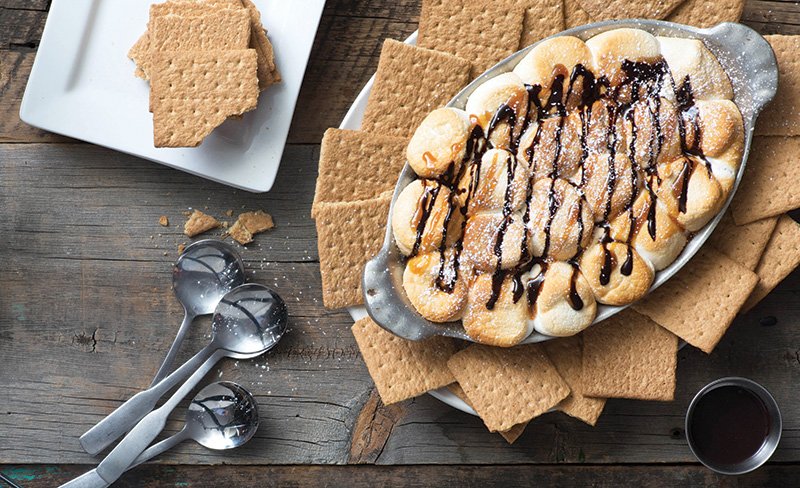
A bit of whimsy in a big, shareable dessert: Campfire Brownie + Cookies + S’mores is a surefire crowd-pleaser at Tom’s Urban.
Share-Worthy Winners
Diners seem more likely to share desserts on social media than other foods, perhaps because there’s an inherent sense of indulgence, fun and conviviality that comes with a decadent, over-the-top dessert. Menuing those showstoppers that demand a click and a share is a winning strategy for both reach and buzz.
Milkshake-makers all over the country have every right to be jealous of the $15 milkshakes at Black Tap Craft Burgers & Beer, with four locations in New York. These amazingly colorful, mouthwatering concoctions include The Cookie Shake, where a vanilla shake sees a vanilla-frosted rim with cookie crumbles topped with a “cookiewich,” chocolate chips, whipped cream and chocolate drizzle. The Sweet n’ Salty peanut butter shake stars peanut butter ice cream, chocolate gems and mini peanut butter cups, topped with a Sugar Daddy, pretzel rods, a chocolate-covered pretzel, whipped cream and chocolate drizzle. These and other favorites on the shake menu have amassed Black Tap tens of thousands of likes on Instagram, and the reason is their “wow” factor.
“The more you get people interested in your items, the more it will pull diners into your restaurants, and of course you want ‘Oh wow!’ desserts that will make people talk,” says Greg Rapp, a Palm Springs, Calif.-based menu consultant. And even better than getting people to talk, inspiring them to share images on social media platforms can have stratospheric results for your business and your reputation.
Take New York’s Eggloo, whose egg waffles have helped build nearly 25,000 Instagram followers. Diners pick a cone or sundae creation, choose an original, chocolate or green tea flavor for their egg waffle, add ice cream and select unlimited colorful toppings for their confection, such as Fruity Pebbles, condensed milk, Pocky and sprinkles. The result is a dessert that is pure eye candy.
Owner Michael Tan began offering the concoctions last September. “We aspired to make our dessert creations into something people would love aesthetically and want to share with others, and I guess that resonated with diners. There is a saying in the social media age: ‘The camera eats first.’ So we tried to make our cones look as crazy and interesting as possible, because that’s really where the curiosity grows and becomes a craving.” Attracting an Instagram following was a big part of Tan’s marketing strategy and has boosted his business. “We notice that every time we make a new post on Instagram, we see a slight uptick in customers the next day,” he says.
Other Instagram-worthy desserts include the ConeChurro at ChikaLicious Dessert Bar in New York. A fried-dough pastry is transformed into an ice cream cone, filled high with soft-serve ice cream and decorated with colorful levels of sprinkles, nuts, and fruity or chocolate sauces. Social media also loves the Donut Ice Cream Sandwich at New York’s Holey Cream: a large doughnut split and filled with scoops of ice cream. Both desserts take a traditional favorite and add new elements of sweet surprise that bolster the item’s size, color and taste profile.
Desserts need not be over-the-top to garner Instagrammable admiration. Whimsy does the trick, too. Sophia’s, an Italian-American supper club in Austin, Texas, menus Tiramisu Pops with mascarpone, coffee and housemade lady fingers in a push-pop. Tom’s Urban, a four-unit American gastropub, offers Campfire Brownie + Cookies + S’mores, an oven-baked dish of toasted marshmallows with brownie batter and chocolate chip cookie dough. Both desserts are decadent and beyond-the-ordinary, yet feature ingredients everyone knows and loves—perfect for social media.
“Anything you can do to encourage Instagramming and spreading the word about your dessert is to your benefit, so consider a contest, for example,” Rapp suggests. “The more ‘wow!’ it is, the more play you’re going to get.”
For forward-thinking restaurant operators, there’s never been a better time to create innovative treats that hit that sweet spot with a mix of novelty, comfort, nostalgia and creativity.







